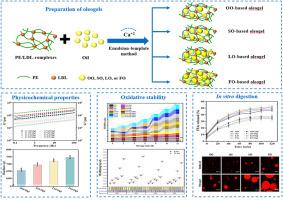脂肪酸不饱和水平对果胶/低密度脂蛋白基油凝胶理化性质和氧化/消化稳定性的影响
IF 11
1区 农林科学
Q1 CHEMISTRY, APPLIED
引用次数: 0
摘要
本研究旨在确定脂肪酸组成对由果胶(PE)和蛋黄低密度脂蛋白(LDL)构建的乳液模板油凝胶的理化、氧化和消化性能的影响。将橄榄油(OO)、大豆油(SO)、亚麻籽油(LO)和鱼油(FO)四种不饱和程度不同的油掺入PE/ ldl基油凝胶中。结果表明,以富含多不饱和脂肪酸(PUFA)的油(FO和LO)配制的油凝胶,由于凝胶基质中的分子间键更强,具有更高的粘度(4856和4456 Pa s)、硬度(745和721 g)、油结合能力(98.85和97.69%)和热稳定性。氧化稳定性评估显示,在富含pufa的系统中,油凝胶化显著抑制了初级和次级脂质氧化,当添加BHA时进一步改善。体外消化实验表明,与散装油相比,油凝胶有效地降低了游离脂肪酸的释放和脂肪的生物可及性,其中以fo为基础的油凝胶效果最低。此外,相关分析还明确了脂肪酸谱与油凝胶性能之间的关系,为优化配方提供了科学依据。这些发现提供了有价值的见解,剪裁功能油凝胶与改善氧化稳定性和调节脂质消化。本文章由计算机程序翻译,如有差异,请以英文原文为准。

Impact of fatty acid unsaturation levels on the physicochemical properties and oxidative/digestive stability of pectin/LDL-based oleogels
This work aimed to determine the impact of fatty acid composition on the physicochemical, oxidative, and digestive properties of emulsion-templated oleogels structured using pectin (PE) and egg yolk low-density lipoprotein (LDL). Four oils with varying degrees of unsaturation, including olive oil (OO), soybean oil (SO), linseed oil (LO), and fish oil (FO), were incorporated into PE/LDL-based oleogels. Results showed that oleogels formulated with polyunsaturated fatty acid (PUFA)-rich oils (FO and LO) exhibited higher viscosity (4856 and 4456 Pa s), hardness (745 and 721 g), oil-binding capacity (98.85 and 97.69 %), and thermal stability than others, due to stronger intermolecular bonds in the gel matrix. Oxidative stability assessments revealed that oleogelation significantly suppressed both primary and secondary lipid oxidation in PUFA-rich systems, with further improvements when BHA was added. The in vitro digestion showed that oleogels effectively reduced free fatty acids release and fat bioaccessibility compared to bulk oils, with FO-based oleogels showing the lowest. Furthermore, correlation analyses establish clear relationships between fatty acid profiles and oleogel performance, providing a scientific basis for optimizing formulations. These findings provide valuable insights for tailoring functional oleogels with improved oxidative stability and modulated lipid digestion.
求助全文
通过发布文献求助,成功后即可免费获取论文全文。
去求助
来源期刊

Food Hydrocolloids
工程技术-食品科技
CiteScore
19.90
自引率
14.00%
发文量
871
审稿时长
37 days
期刊介绍:
Food Hydrocolloids publishes original and innovative research focused on the characterization, functional properties, and applications of hydrocolloid materials used in food products. These hydrocolloids, defined as polysaccharides and proteins of commercial importance, are added to control aspects such as texture, stability, rheology, and sensory properties. The research's primary emphasis should be on the hydrocolloids themselves, with thorough descriptions of their source, nature, and physicochemical characteristics. Manuscripts are expected to clearly outline specific aims and objectives, include a fundamental discussion of research findings at the molecular level, and address the significance of the results. Studies on hydrocolloids in complex formulations should concentrate on their overall properties and mechanisms of action, while simple formulation development studies may not be considered for publication.
The main areas of interest are:
-Chemical and physicochemical characterisation
Thermal properties including glass transitions and conformational changes-
Rheological properties including viscosity, viscoelastic properties and gelation behaviour-
The influence on organoleptic properties-
Interfacial properties including stabilisation of dispersions, emulsions and foams-
Film forming properties with application to edible films and active packaging-
Encapsulation and controlled release of active compounds-
The influence on health including their role as dietary fibre-
Manipulation of hydrocolloid structure and functionality through chemical, biochemical and physical processes-
New hydrocolloids and hydrocolloid sources of commercial potential.
The Journal also publishes Review articles that provide an overview of the latest developments in topics of specific interest to researchers in this field of activity.
 求助内容:
求助内容: 应助结果提醒方式:
应助结果提醒方式:


